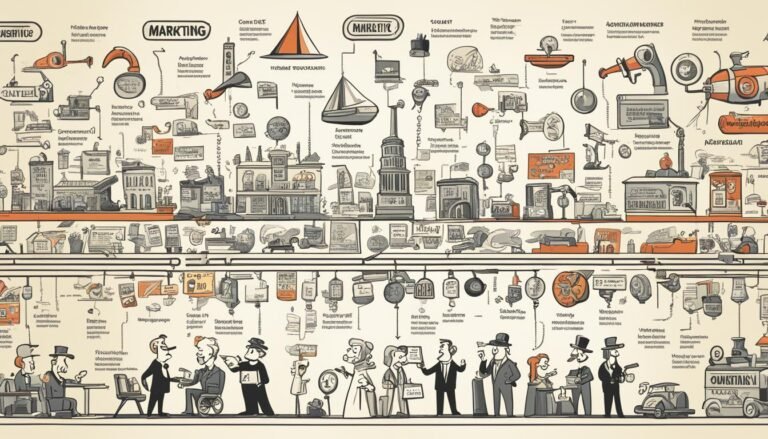Key Figures in Marketing Theory
Did you know Philip Kotler has written 147 articles for top journals? This shows his big impact on marketing. He’s known as the father of modern marketing. Kotler put his work into nine main areas that form marketing theory’s base.
Knowing the key ideas from experts like Kotler is vital for marketers who want to do well. These theories, from the Seven Ps of Marketing Mix to Porter’s Five Forces, give great insights into how people buy and what makes markets work. They help businesses make strategies that meet customer needs, stand out, and grow over time.
Key Takeaways
- Philip Kotler’s work includes 147 articles in top journals.
- Core marketing theories offer deep insights into how people buy and market dynamics.
- Using these theories helps in making strategies and making products unique.
- Good communication with the audience is key for marketing success.
- Marketing strategies based on these theories help businesses grow sustainably.
Philip Kotler: The Father of Modern Marketing
Philip Kotler is known as the “Father of Modern Marketing.” He was born on May 27, 1931. Kotler has greatly influenced marketing with his work. Let’s look at his early life, major contributions, and lasting impact.
Early Life and Education
Philip Kotler started his marketing journey with a strong academic background. He got a Master’s degree from the University of Chicago and a Ph.D. in Economics from MIT. This education set the stage for his future in marketing.
Major Contributions
Kotler has written over 80 books and more than 166 articles. His famous book, Marketing Management: Analysis, Planning, and Control, first came out in 1967. It’s now in its 15th edition and is a key text in business schools.
Kotler made the 4Ps of marketing famous: product, price, place, and promotion. These ideas are key to understanding how to reach different customers. He also stressed the need to focus on customers in marketing.
Kotler pointed out the importance of making brands stand out. He used companies like Apple and Unilever as examples. His ideas show how marketing should evolve with changing customer needs.
Legacy in Marketing
Kotler’s impact goes beyond his books. He has won many awards, including the “Leader in Marketing Thought” award in 1975 and the William L. Wilkie “Marketing for a Better World” award in 2013. His work helps shape modern marketing, especially in targeting different markets and understanding customer behavior.
Kotler predicted the growth of online shopping and the decline of traditional stores. His insights are still vital today, helping marketers create effective strategies that connect with consumers.
Michael Porter: Competitive Forces and Strategy
Michael Porter changed how businesses see competitive edge with his new ideas. His Five Forces model helps companies understand complex markets.
Porter’s Five Forces
Porter’s Five Forces model looks at an industry’s structure and profits. It checks five main forces:
- Internal competition
- Potential new entrants
- Bargaining power of suppliers
- Bargaining power of customers
- Threat of substitute products
This framework helps businesses see how they compete. It looks at things like how many competitors there are and how different products are. It also looks at costs and barriers to leaving the market.
When it’s easy to start a new business, there’s more competition and lower profits. The threat of new companies comes from things like being big, making different products, needing a lot of money, and rules.
Impact on Business Strategy
Porter’s model needs a deep look at the industry to see how forces like competition and new companies work. Suppliers can really affect profits if there are few of them or it’s hard to switch. Customers can also lower profits by asking for better deals.
If there’s a big threat of new products, companies must keep innovating to stay ahead. Also, lots of competition, because of slow growth and high costs, can make profits go down.
Books and Publications
Michael Porter’s books are key in business education and practice. Works like “Competitive Strategy” and “Competitive Advantage” give deep insights. They help businesses use strategies that go beyond marketing, affecting competition and strategy.
Peter Drucker: The Pioneer of Modern Management
Peter Drucker is known as the father of modern management. He brought forward key ideas that still shape today’s management practices. He stressed the need for a business to focus on creating and serving customers.
Drucker believed in decentralization, giving power to employees. This approach cuts down the time top executives spend on making decisions. It boosts business efficiency.
He also introduced Management by Objectives (MBO). This method helps set goals, track progress, and check performance. Using SMART goals is seen as a key to success for many organizations.
Drucker valued knowledge work and creativity. He saw the importance of solving problems creatively and investing in employee growth. This approach helps in driving innovation and making businesses more efficient.
Drucker believed in corporate social responsibility (CSR). He saw businesses as part of the social fabric. He argued that being ethical and responsible can lead to better profits, a good reputation, and more innovation.
His book “The Practice of Management,” published in 1954, shared these groundbreaking ideas. For over 80 years, his principles have guided marketers and leaders. They help create value for customers and improve efficiency.
Theodore Levitt: Marketing Myopia and Beyond
Theodore Levitt changed the game with his work “Marketing Myopia.” He showed how focusing too much on quick wins can hurt businesses. He pushed for a long-term view that puts customer focus at the core for lasting success.
Concept of Marketing Myopia
In 1960, Levitt pointed out a big mistake: many companies sold products without really understanding customer needs. This narrow focus led to missed chances and slow growth. For example, old industries like transportation and energy struggled because they didn’t innovate or adapt.
Levitt said lasting growth comes from finding new opportunities. He stressed the importance of making products better, not just selling more. The failure of companies like Blockbuster shows the danger of ignoring changing consumer needs.
Other Contributions
Levitt also talked about the power of combining research and development for innovation. Companies that improve their products with new tech can lead the industry.
He also highlighted marketing’s key role in adding value, meeting customer needs, and boosting profits. His work covers many marketing aspects, pushing for a full and innovative approach.
In today’s digital world, Levitt’s ideas are still key. Companies need to be efficient, manage costs well, offer great customer service, and be strong online. By using Levitt’s ideas and new tech like AI and big data, businesses can thrive in a complex market.
Levitt’s influence has made him a key figure in marketing theory. His work guides and motivates today’s marketing, aiming for a future-focused, customer-centered approach for lasting success.
Everett Rogers: Diffusion of Innovations
Everett Rogers introduced the Diffusion of Innovations theory in 1962. It’s now a key framework for understanding how new ideas spread. This theory is used in many fields, like marketing, health, and education. It helps strategists understand how to move through the product life cycle.
Introduction to Diffusion Theory
Rogers’ theory has been crucial in managing innovation since its start. It helps analyze how new ideas spread in a group. Key parts of the theory include Relative Advantage, Compatibility, and Complexity. These factors look at how new ideas compare to old ones and how easy they are to adopt.
Other important parts are Triability and Observability. Triability looks at if an innovation can be tested before full adoption. Observability checks if the innovation’s effects are easy to see.
Stages of Adoption
Rogers says there are five types of people who adopt new ideas at different times:
- Innovators: These are about 2.5% of people who love new ideas and are open to risks.
- Early Adopters: This group, making up 13.5%, can influence others to adopt new ideas.
- Early Majority: About 34% of people, they are key as their opinions can shape the market.
- Late Majority: Another 34% adopt new ideas once they see others doing it.
- Laggards: The last 16%, they are slow to accept new changes.
The point where Early Majority and Late Majority meet is key for big changes. Knowing these stages helps businesses aim for wide adoption and growth over the product’s life.
Influence on Marketing Strategies
Knowing what drives people to adopt new ideas is crucial for marketing. Focusing on Early Adopters can lead to wider acceptance and longer success for new products. Adjusting marketing to fit different adoption patterns is key for the best results.
Everett Rogers’ theory still gives deep insights into managing innovation. It offers a structured way to promote new products and ideas through different stages of adoption.
Regis McKenna: Technology Marketing Visionary
Regis McKenna is a giant in high-tech marketing. He has greatly influenced Silicon Valley’s marketing and brand growth. Over 50 years, he has changed how tech companies market themselves.
Role in Silicon Valley
McKenna is a legend in Silicon Valley. He helped many start-ups, like America Online and Apple, grow. His knowledge helped these companies stand out in the tech world.
Influence on Tech Marketing
McKenna has deeply influenced tech marketing. He introduced models like the Marketing Chasm and the Bowling Pin strategy. These ideas help tech companies grow over time.
His books, “Real Time” and “TOTAL ACCESS,” are key to understanding tech consumers and building brands. He has also advised companies in the U.S., Japan, and Europe on marketing and business.
His advice has been shared on TV shows like NightLine and The Today Show. This has made him a big name in high-tech marketing.
Now, as Chairman of the Santa Clara University Center for Science, Technology and Society, McKenna keeps shaping tech and marketing. His work shows how smart positioning and brand building lead to success in tech.
Seth Godin: Modern Marketing Guru
Seth Godin is a top name in modern marketing. He focuses on permission marketing and digital engagement. He has written over 20 books and is a big investor, always pushing the limits in connecting with customers.
Key Ideas and Books
Godin introduced the idea of permission marketing, changing how companies talk to customers. His blog gets millions of views every day, showing his big impact in marketing. He wrote “Purple Cow” about making products that grab attention and “Linchpin” about being essential in your job.
In “This is Marketing,” he gives a five-step plan for marketing success. He talks about the power of empathy, telling stories, and focusing on a specific audience.
Impact on Digital Marketing
Godin has made a big mark on digital marketing. He talks about the power of engaging online and telling brand stories. He believes in sharing valuable content to keep customers interested.
Godin says being real is key. He thinks marketers should make products worth talking about and tell stories that match what customers dream of. He leads by example, showing how marketers can start movements and lead groups for lasting online success.
Al Ries: The Champion of Positioning Theory
Al Ries is a big name in marketing, known for his work with Jack Trout. Together, they introduced the idea of brand positioning. Their ideas have changed how companies talk to customers and stand out in the market.
Co-Authoring with Jack Trout
Al Ries teamed up with Jack Trout to write “Positioning: The Battle for Your Mind.” This book has been translated into 22 languages and is a worldwide best-seller. Their work showed how businesses can make a unique mark in people’s minds.
Core Principles of Positioning
Ries and Trout laid down key rules for making a brand stand out. They stressed the importance of brand positioning. Companies must have clear and consistent strategic messaging to connect with their audience.
Using market differentiation, companies can gain a lasting edge over competitors. This helps them shine in a crowded market.
Experts agree, 91% of them, that Ries and Trout’s positioning strategies work well. Their ideas are still powerful, even as markets change. The principles of positioning are a strong guide for business success.
Jack Trout: Mastermind of Marketing Warfare
Jack Trout changed the game with his marketing ideas, especially in marketing warfare. He showed companies how to stand out in a crowded market. His strategies have shaped how businesses use marketing to get ahead.
Collation with Al Ries
In the late 20th century, Jack Trout joined forces with Al Ries. Together, they came up with groundbreaking marketing ideas. Their work led to the famous book “Positioning: The Battle for Your Mind”. This book changed how brands see and place themselves in the market.
Key Publications
Trout has written many important books for marketers. Besides “Positioning: The Battle for Your Mind”, he wrote “Marketing Warfare” and “The 22 Immutable Laws of Marketing”. These books highlight the need for a strong competitive strategy. They’re key for anyone wanting to grasp the competitive world of brands.
Influence on Marketing Tactics
Jack Trout’s impact on marketing is huge. He suggested that companies should think like military strategists. They need to use both aggressive and defensive marketing to keep their spot in the market. This idea is now seen in how brands compete and lead in their fields.
Key Figures in Marketing Theory: Integrative Analysis
Looking at key figures in marketing theory shows us important insights that have shaped marketing. These leaders brought unique views that shape today’s marketing. Their ideas blend well, giving us a full picture of marketing.
Common Themes and Differences
Marketing pioneers like Philip Kotler, Michael Porter, and Peter Drucker share some key ideas. They all stress the need to focus on customers, have a strong strategy, and innovate. Yet, they use different ways to get there:
- Philip Kotler put the customer at the center, showing how important it is to meet their needs.
- Michael Porter looked at competition and how to stand out, with tools like the Five Forces.
- Peter Drucker talked about innovation and good management, key to success.
These similarities and differences have led to new ideas, making marketing richer and more varied.
How Their Theories Interact
The ideas from these pioneers help us understand and use marketing well. For example, Kotler’s focus on customers works well with Porter’s strategies. Drucker’s ideas on innovation boost both. Marketing theory has grown by combining fields like economics, psychology, and sociology.
Vargo and Lusch’s ideas on working together and value networks show how these theories connect. Their ideas match Drucker’s on innovation and Porter’s on strategy. This mix helps marketers use a wide range of strategies for lasting success and happy customers. This way, marketing has grown, helping both businesses and customers.
Impact of Marketing Theory on Modern Practices
Marketing theories have changed how businesses work today. They help companies use new ideas and methods. This keeps them fresh and growing, often setting new records.
Examples of Theories in Action
Apple is a great example of using marketing theories well. They focus on product, price, promotion, and place. This has helped them stand out in the market.
UNIQLO also uses pricing and product differences to meet customer needs. These examples show how good marketing theories work. They also set standards for others to follow.
Tesla uses Porter’s Five Forces to deal with competition. This shows how theories can help in real life.
Case Studies
Looking at different companies shows how marketing theories work. Procter & Gamble uses theories to predict market trends and make better products. Nike uses theories of consumer psychology to stay ahead in the market.
Future Trends
Marketing theory will keep changing with new tech and changing consumer habits. Digital tools and data will change how we use marketing theories. Industry benchmarking will use big data more.
Marketers need to be ready for these changes. Using flexible marketing theories will help them stay successful and keep innovating.
Conclusion
Key figures in marketing theory have greatly influenced modern marketing. Philip Kotler and Seth Godin, among others, have shaped marketing leadership. Their ideas help us adapt to new challenges and chances.
Their work includes frameworks like Porter’s Five Forces and the Marketing Mix’s Seven Ps. These tools help us understand and navigate the changing marketing world.
Classic marketing theories are still vital today. Concepts like market segmentation and the Consumer Decision-Making Process guide us. They help marketers tackle issues, like the 47% who find social marketing hard.
These theories provide a strong base for making decisions. They help us build successful campaigns, using Maslow’s Hierarchy of Needs or the TIU approach.
Collaboration between managers, consumers, and policymakers makes these theories more relevant. They are key for marketing’s future growth and innovation. As we move forward, combining old wisdom with new techniques will shape marketing.
Source Links
- Philip Kotler’s contributions to marketing theory and practice
- Marketing Theory – an overview
- Philip Kotler
- ‘Father of modern marketing’ Philip Kotler on avoiding brand decay
- Porter’s Five Forces Explained and How to Use the Model
- The Five Forces – Institute For Strategy And Competitiveness
- Michael Porter’s 5 Forces Explained: A Marketer’s Guide | Target Internet
- Peter Drucker’s Management Theory Explained
- What Is Peter Drucker’s Management Theory?
- Marketing Myopia by Theodore Levitt (1960), a deep analysis in today’s context!
- Modern Marketing Myopia: is marketing losing perspective?
- Marketing myopia
- Diffusion of Innovation Theory
- Reading: Diffusion of Innovation | Principles of Marketing
- Regis McKenna | Speaker Agency, Speaking Fee, Videos
- Don’t Get Confused About Crossing The Chasm Framework
- Seth Godin: The Marketing Guru Shaping the Digital Age
- What is Marketing according to Seth Godin – The Adaptive Marketer
- applicability to the administration of public radio stations operated by institutions of higher education"
- Brand positioning : strategies for competitive advantage [2. ed., 6. repr.] 9780070581593, 0070581592 – DOKUMEN.PUB
- What is the Secret of Ulker’s Marketing Success? Could 75% of Companies Perish By 2027? – Part 2
- REPOSITIONING: Marketing in an Era of Competition, Change and Crisis by Jack Trout, Steve Rivkin (Ebook) – Read free for 30 days
- Positioning: The battle for your mind
- Simon Leadbetter on LinkedIn: #marketing #strategy
- 12_m18-091_165-180.docx
- Marketing’s theoretical and conceptual value proposition: opportunities to address marketing’s influence – AMS Review
- The Sport Marketing Portfolio Matrix: A Theory-Integrative Exploration of Fans’ “Buy,” “Hold,” and “Sell” Behaviors
- The pragmatic importance of theory for marketing practice
- jppm.27.2.202
- 6 important marketing theories—and how to apply them in social media campaigns
- Reinvigorating Interest in Marketing Theories [Expert Insights]
- Marketing Theories: the Consumer Decision Making Process







